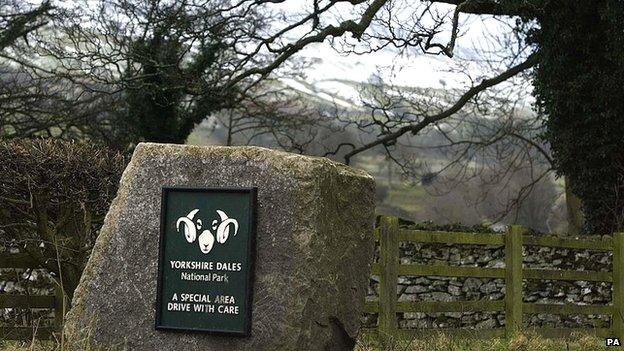National parks face biggest change to governance
- Published
- comments

The governance of the national parks could be about to see its biggest change in six decades
As I drove around Yorkshire this week there was no mistaking the route of the Tour de France through Yorkshire.
Spray-painted yellow bikes stuck on walls compete with thousands of banners and flags.
It is mass mobilisation with road closure signs in place for race days and temporary camp sites and car parks being prepared.
Even one of my favourite pubs, The Waggon and Horses at Langsett in South Yorkshire, has temporarily changed its name to The Pedalers in honour of riders in Europe's biggest sporting event flashing by.
The cafe across the road has come out in spots - its walls now painted like a giant King of the Mountains shirt.
True grit
In all the razzmatazz one little sign might be missed as the peloton heads out of the West Yorkshire "Last of the Summer Wine" Pennine market town of Holmfirth and starts the long climb up the moorland road to the summit at Holme Moss on its way to Sheffield.
It is a round granite millstone propped up at the side of the road.
Pass it and you are in the boundaries of the Peak District National Park which spans the rugged spectacular moorlands bordering West and South Yorkshire.
It is certainly no coincidence that the Tour organisers chose a county with three national parks to stage the opening two days of the 2014 competition - the "Grand Depart".
By the time the riders have reached the top of Holme Moss they will already have gone right through one of the county's other National Parks, the Yorkshire Dales, and come within spitting distanced of the third - the North York Moors.
Economic windfall
These huge areas of natural beauty became parks over 60 years ago in order to give them legal protection from encroaching modernisation and urbanisation.
The windfall in the 21st Century is they are now at the heart of a tourism industry that draws in 30 million visitors a year, film and TV production companies and now major money-spinning events like the Tour de France.
But who oversees the running of the national parks and are they up to the job?
Well there has just been a pretty broad hint that the government believes the growing economic role of the parks is far beyond the system devised in the 1950s where each park is run by an authority made up of appointed members with most seats on it reserved for local councillors.
The messenger was Her Majesty the Queen.
In her annual address on the opening of Parliament her speech contained just one line that could see the biggest change to governance in the six decades of the parks.
She said her government would introduce legislation to enable ballot boxes to be used in the parks for the first time with the suggestion that members should be directly elected.
It is likely to be fiercely debated with many of those on the authorities at the moment saying they are already elected as local councillors.
Others point out that being elected for one body does not mean they can be held accountable for the decisions they make about another one.
Suddenly the quiet and tranquillity of the parks could be disturbed... and I am not talking about the peloton passing through.